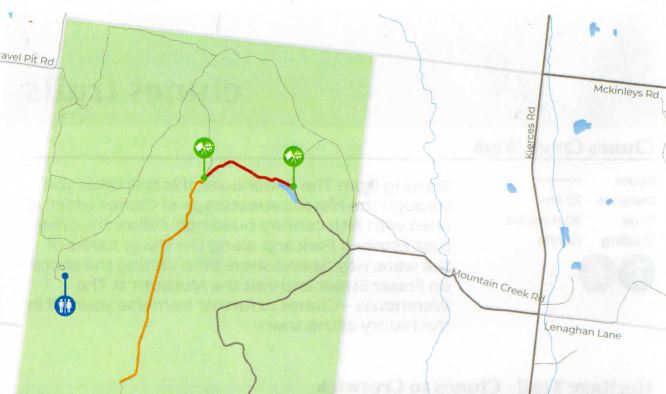Mount Beckworth Scenic Reserve

Situated eight kilometres west of the township of Clunes, the Mount Beckworth Scenic Reserve surrounds the summit of the impressive mountain and features a network of tracks through open woodlands and springtime wildflowers.
A lone pine tree stands as a sentinel crowning this picturesque granite outcrop. The lone tree at the summit, known as the "lollipop" tree, is a district landmark. In the 1940s a number of pine trees were removed from the summit and the remaining tree had its lower limbs pruned.
The best way to enjoy the park is on foot. A network of tracks links all major features within the reserve. A walk to the summit is rewarded with breathtaking views of the surrounding countryside. Other activities that can be enjoyed in the park are camping, picnicking, horse riding and mountain biking.
Camping is allowed for short stays at Cork Oaks Picnic Area, The Dam Picnic Area and Manna Gums Picnic Area. No booking required and no fees apply.
Noe that the Mountain Creek Road is unsealed and corrugated. Also the road to the dam is just wide enough to fit one car only with few opportunities to pull aside to allow oncoming vehicles to pass.
Mount Beckworth Scenic Reserve Walks Map

The Dam to the Oval Walk
Route: See red line on map above
Distance: 1.7km
Time: 30 minutes
Grading: Easy to moderate
Enter Mount Beckworth from Mountain Creek Road and turn right, following the signage to The Dam picnic area and car park. For great views of the surrounding area take this trail to the clearing at the oval.
The Oval to the Summit Walk
Route: See orange line on map above
Distance: 3.3km
Time: 2 hours
Grading: Adventurous
Follow the signage past The Oval to the summit of Mount Beckworth. From the summit you will have some breathtaking views of the surrounding countryside.
Access for Dogs:
Dogs must be controlled on a leash at all times. Please clean up after your dog.
Why the Lollipop Tree Watches Over Us
Mount Beckworth consists of granite pushed up through Ordovician rock by volcanic action some 300 million years ago. Originally much higher, it has weathered down to its present level of 2087 feet.
Controversy, and a little mystery, has surrounded the lone pine tree - known to some as the 'Lollipop Tree' - on the summit.
In the early 1970s Mr Col Drife of Mt Beckwith Homestead said this tree on Flagstaff Peak was one of a stand planted by Forest Ranger Jack Scarfe in mid-1918. According to Mr Drife, Jack was Ranger from about 1916 to 1931.
The name 'Flagstaff Peak' derived from the practice of hoisting a flag when someone returned from Melbourne or Sydney with mail for any of the local landholders. This was before the days of regular mail deliveries.
"Mr Scarfe was stationed at Maryborough and often made his tour of the Mount by horse or bicycle, camping in the Rangers Hut on the west side of the range. This but was eventually overgrown by the pines, but was still visible in the 1970s.
In 1916 a start was made to clear and rabbit-proof an area on the west side of the range which was to be planted with Pinus Radiata. This took place between 1916 and 1918."
Mr Drife continued: "There were four small boys at the nearby Glendaruel State School. They were Stanley Andrews, William Young (my cousin), Francis Kinnersley and myself. The fathers of the other three boys worked on clearing and fencing the area for the pines.
"We spent a lot of time roaming the Mount and got to know the Ranger very well. He was a nice bloke and taught us a lot about trees.
"Like schoolboys everywhere we asked a lot of questions, one being 'why were the trees planted on the wet flats, when our school books told us that these trees in their natural habitat grew better the higher up the mountain they grew?'
"He replied: 'Well, my boys, we will try just that.'
"So five trees were planted on the highest peak. Around each tree was placed a netting guard which acted as a windbreak as well.
"Jack Scarfe cared for these trees until they were well established. By the time he retired in 1931 the trees were good healthy specimens, equal to - if not better than - those planted on the flats. If I remember rightly there were around 84,000 trees planted In the area at that time.
"Now for the story, of the tree that stands alone. About 1945 , What I call departmental vandalism, took place. The trees were ordered to be cut down to make way for an aerial survey beacon or some such thing.
"I was shocked when my neighbour, James Branigan and Joe Morrison, who lived in the Ranger's hut after Mr Scarfe left, who were employed on the' plantations, told me they were ordered to cut the trees down.
"The three of us held a council of war and decided that because it was a wartime move we could do little. Branigan and Morrison cut down four of the five trees, but the best specimen they refused to cut down. Instead, Branigan climbed up and pruned off the branches as high as it was safe to go," concluded Mr Drife.
So, today, the Lollipop Tree still remains as a silent sentinel over the surrounding plains - thanks to the curiosity of four small boys long ago and the bloody mindedness of three grown men.
by Ros O'Brien (letters to the Editor, The Bush Telegraph)
Location
Mountain Creek Road, Mount Beckworth 3363 Map
Web Links
→ www.parks.vic.gov.au/places-to-see/parks/mount-beckworth-scenic-reserve









